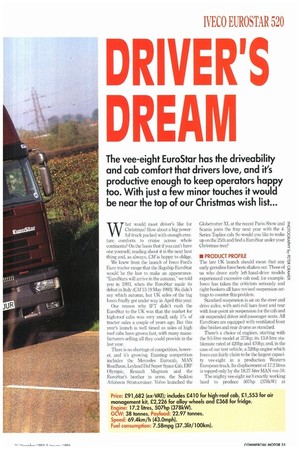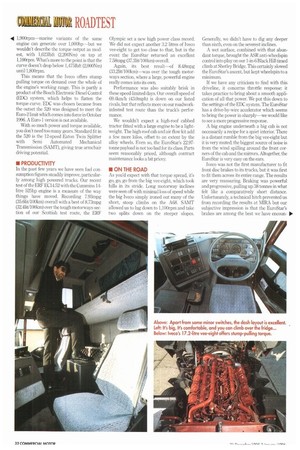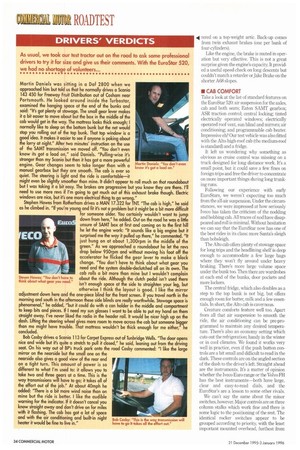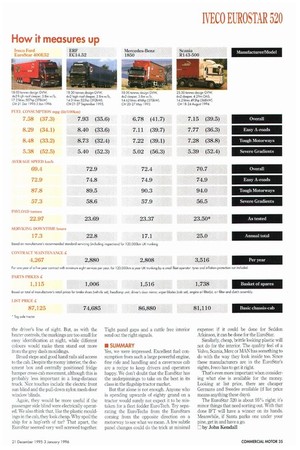The vee-eight EuroStar has the driveability and cab comfort that
Page 33

Page 34

Page 36

Page 37

If you've noticed an error in this article please click here to report it so we can fix it.
drivers love, and it's productive enough to keep operators happy too. With lust a few minor touches it would be near the top of our Christmas wish list...
What would most driver's like for Christmas? How about a big powerful truck packed with enough creature comforts to cruise across whole continents? On the basis that if you can't have one yourself, reading about it is the next best thing and, as always, CM is happy to oblige.
We knew from the launch of Iveco Ford's Ettro tractor range that the flagship EuroStar would be the last to make an appearance. "EuroStars will arrive in the autumn," we told you in 1993, when the EuroStar made its debut in Italy (CM13-19 May 1993). We didn't say which autumn, but UK sales of the big Iveco finally got under way in April this year.
One reason why 11.7 didn't rush the EuroStar to the UK was that the market for high-roof cabs was very small; only 5% of tractor sales a couple of years ago. But this year's launch is well timed as sales of high roof cabs have grown fast, with many manufacturers selling all they could provide in the last year.
There is no shortage of competition, however, and it's growing. Existing competition includes the Mercedes Eurot2b, MAN Roadhaus, Leyland Daf Super Space Cab, ERF Olympic, Renault Magnum and the EuroStar's brother in arms, the Seddon Atkinson Stratocruiser. Volvo launched the Globetrotter XL at the recent Paris Show and Smnia joins the fray next year with the 4Series Topline cab. So would you like to wake up on the 25th and find a EuroStar under your Christmas tree?
• PRODUCT PROFILE
The late UK launch should mean that any early gremlins have been shaken out. Those of us who drove early left-hand-drive models experienced excessive cab nod, for example. Iveco has taken the criticism seriously and right-hookers all have revised suspension settings to counter this problem.
Standard suspension is air on the steer and drive axles, with anti-roll bars front and rear with four-point air suspension for the cab and air suspended driver and passenger seats. All EuroStars are equipped with ventilated front disc brakes and rear drums as standard.
There's a choice of engines, starting with the 95-litre model at 375hp; its 13.8-litre stablemate rated at 420hp and 470hp; and, in the case of our test vehicle, a 520hp engine which Iveco can fairly claim to be the largest capacity 'ee-eight in a production Western European truck. Its displacement of 17.2 litres is topped only by the 18.27-litre MAN vee-10.
The mighty vee-eight isn't exactly working hard to produce 507hp (378kW) at 1,900rpm—marine variants of the same engine can generate over 1,000hp—but we wouldn't describe the torque output as modest, with 1,6231bft (2,200Nm) on tap at 1,100rpm. What's more to the point is that the curve doesn't drop below 1,4751bft (2,000Nm) until 1,800rpm.
This means that the Iveco offers stump pulling torque on demand over the whole of the engine's working range. This is partly a product of the Bosch Electronic Diesel Control (EDC) system, which helps to flatten the torque curve. EDC was chosen because from the outset the 520 was designed to meet the Euro-2 limit which comes into force in October 1996. A Euro-1 version is not available.
With so much power and torque available, you don't need too many gears. Standard fit in the 520 is the 12-speed Eaton Twin Splitter with Semi Automated Mechanical Transmission (SAMT), giving true armchair driving potential.
• PRODUCTIVITY In the past few years we have seen fuel consumption figures steadily improve, particularly among high powered trucks, Our recent test of the ERF EC14.52 with the Cummins 14litre 525hp engine is a measure of the way things have moved. Recording 7.93mpg (35.61it/100km) overall with a best of 8.73mpg (32.41it/100km) over the tough motorways section of our Scottish test route, the ERF Olympic set a new high power class record. We did not expect another 3.2 litres of Iveco vee-eight to get too close to that, but in the event the EuroStar returned an excellent 7.58mpg (37.31it/100km) overall, Again, its best result—of 8.48mpg (33.21it/100km)—was over the tough motorways section, where a large, powerful engine really comes into its own.
Performance was also suitably brisk in these speed-limited days. Our overall speed of 69.4km/h (43.0mph) is down on our listed rivals, but that reflects more on our roadworkinfested test route than the truck's performance.
We wouldn't expect a high-roof cabbed tractor fitted with a large engine to be a lightweight. The high-roof cab and air flow kit add a few more kilos, offset to an extent by the alloy wheels. Even so, the EuroStar's 22.97tonne payload is not too bad for its class. Parts seem reasonably priced, although contract maintenance looks a bit pricey.
• ON THE ROAD As you'd expect with that torque spread, it's go, go, go from the big vee-eight, which took hills in its stride, Long motorway inclines were seen off with minimal loss of speed while the big Iveco simply ironed out many of the short, steep climbs on the A68. SAMT allowed us to lug down to 1,100rpm and take two splits down on the steeper slopes. Generally, we didn't have to dig any deeper than sixth, even on the severest inclines.
A wet surface, combined with that abundant torque, brought the ASR anti-wheelspin control into play on our 1-in-6 Black Hill timed climb at Shotley Bridge. This certainly slowed the EuroStar's ascent, but kept wheelspin to a minimum.
If we have any criticism to find with this driveline, it concerns throttle response: it takes practice to bring about a smooth application of all that power. We put this down to the settings of the EDC system. The EuroStar has a drive-by-wire accelerator which seems to bring the power in sharply—we would like to see a more progressive response.
A big engine underneath a big cab is not necessarily a recipe for a quiet interior. There is a distant rumble from the big vee-eight but it is very muted; the biggest source of noise is from the wind spilling around the front corners of the cab and the mirrors. Altogether, the EuroStar is very easy on the ears.
Iveco was not the first manufacturer to fit front disc brakes to its trucks, but it was first to fit them across its entire range. The results are very reassuring. Braking was powerful and progressive, pulling up 38 tonnes in what felt like a comparatively short distance, Unfortunately, a technical hitch prevented us from recording the results at MIRA but our subjective impression is that the EuroStar's brakes are among the best we have encoun
tered on a top-weight artic. Back-up comes from twin exhaust brakes (one per bank of four-cylinders).
Like the engine, the brake is muted in operation but very effective. This is not a great surprise given the engine's capacity. It provided a useful speed check on long descents but couldn't match a retarder or Jake Brake on the shorter A68 slopes.
• CAB COMFORT
Take a look at the list of standard features on the EuroStar 520: air suspension for the axles, cab and both seats; Eaton SAMT gearbox; ASR traction control; central locking; tinted electrically operated windows; electrically operated roof vent, sun blind and mirrors; air conditioning; and programmable cab heater. Impressive eh? Our test vehicle was also fitted with the Alto high-roof cab (the medium-roof is standard) and a fridge.
It left us wondering why something as obvious as cruise control was missing on a truck designed for long distance work. It's a small point, but it could save a few fines on foreign trips and free the driver to concentrate on more important things during long trunking runs.
Following our experience with early EuroStars, we weren't expecting too much from the all-air suspension. Under the circumstances, we were impressed at how seriously Iveco has taken the criticism of the nodding and bobbing cab. All traces of nod have disappeared and roll is minimal. Without hesitation we can say that the EuroStar now has one of the best rides in its class: more Santa's sleigh than bobsleigh.
The Alto cab offers plenty of stowage space for long trips and the headlining shelf is deep enough to accommodate a few large bags where they won't fly around under heavy braking. There's more large volume space under the bunk too. Then there are wardrobes at each end of the bunks, door pockets and more lockers.
The central fridge, which also doubles as a step to the top bunk is not big, but offers enough room for butter, milk and a few essentials. In short, the Alto cab is cavernous.
Creature comforts feature well too. Apart from all that air suspension to smooth the ride, the air conditioning can be pre-programmed to maintain any desired temperature. There's also an economy setting which cuts out the refrigeration; handy in the winter or in cool climates. We found it works very well in practice, even if the push button controls are a bit small and difficult to read in the dark. These controls are on the angled section of the dash to the driver's left. Straight ahead are the instruments. It's a matter of opinion whether the Iveco Euro range or the Volvo FH has the best instruments—both have large, clear and easy-to-read dials, and the EuroStar's are a lesson to some other rivals.
We can't say the same about the minor switches, however. Major controls are on three column stalks which work fine and there is some logic to the positioning of the rest. The identical rocker switches appear to be grouped according to priority, with the least important mounted overhead, furthest from the driver's line of sight. But, as with the heater controls, the markings are too small for easy identification at night, while different colours would make them stand out more from the grey dash mouldings.
Broad steps and good hand rails aid access to the cab. Despite the roomy interior, the document box and centrally positioned fridge hamper cross-cab movement, although this is probably less important in a long-distance truck. Nice touches include the electric front sun blind and the pull-down nylon mesh door window blinds.
Again, they would he more useful if the passenger side blind were electrically operated. We also think that, like the plastic mouldings in the cab, they look cheap. Why spoil the ship for a hap'orth of tar? That apart, the EuroStar seemed very well screwed together. Tight panel gaps and a rattle free interior send out the right signals.
• SUMMARY Yes, we were impressed. Excellent fuel consumption from such a large powerful engine, fine ride and handling and a cavernous cab are a recipe to keep drivers and operators happy. We don't doubt that the EuroStar has the underpinnings to take on the best in its class in the flagship tractor market.
But that alone is not enough. Anyone who is spending upwards of eighty grand on a tractor would surely not expect it to be mistaken for a fleet fodder EuroTech. Try separating the EuroTechs from the EuroStars coming from the opposite direction on a motorway to see what we mean. A few subtle panel changes could do the trick at minimal expense: if it could be done for Seddon Atkinson, it can be done for the EuroStar.
Similarly, cheap, brittle looking plastic will not do for the interior, The quality feel of a Volvo, Scania, Merc or MAN has something to do with the way they look inside too. Since these manufacturers are in the EuroStar's sights, Iveco has to get it right That's even more important when considering what else is available for the money. Looking at list price, there are cheaper Germans and Swedes available (if list price means anything these days).
The EuroStar 520 is about 95% right; it's minor things that need sorting out. With that done IFT will have a winner on its hands. Meanwhile, if Santa parks one under your pine, get in and have a go.
by John Kendall




























































































































